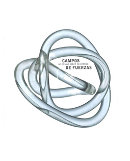
Details
| Title | Force Fields: Phases of the Kinetic |
| Author | Guy Brett, Teresa Grandas |
| Publisher | Hayward Gallery Publishing |
| Published | 1999 |
| Get | Read / watch this |
Related conversations



Related Materials

Recommended by

Force Fields: Phases of the Kinetic
A second premise of this exhibition is that artists, no less than scientists, make 'models of the universe'. Their models are arrived at intuitively but are no less valid, no less a form of knowledge. A thread of 'cosmic speculation' can be followed in the work of many artists between the loose dates of 1920 and 1980 that this exhibition covers. It is a thread of fascinating intricacy, precisely because the structures that artists have arrived at combine an investigation of reality with an investigation of the aesthetic. It is as if speculation on the structure of the universe, for these artists, is inseparable from a transformation of the formal structures of art, and vice versa, that the formal transformation of art is itself a proposition on the structure of the universe. It is surprising that such a widespread enquiry has been so little studied. Its implications are considerable, both in the way they question the art historical categories and schemas which have been handed down to us, and for what they reveal about the nature of 'abstraction'.
We could turn from the image of structural rigour, and from formless flux, to a third metaphor for the universe: the void. Nothing, emptiness, null, zero, the limitless and dimensionless: a mental construct denoting a space of potential in which all things originate. The paradox of referring to 'everything' by 'nothing' has been a key recourse in eastern philosophy and religion – Indian Tantrism, Tibetan mysticism, Taoism, and Zen Buddhism. As we will see in more detail later, the notion of the void surfaces again in mid-20th-century art as a generative and inspirational idea, reflecting an extensive interconnection at the time between western and eastern artists.
One can find in these 'cosmic' works the trapezes and acrobats of [Alexander] Calder's earlier Circus. It is the precarious balance, and the space of the acrobat's leap or swing which doubles with the orbits of the little spheres: the line of wire is the trajectory of both.
[Georges] Vantongerloo's works have remained obscure perhaps because they have been considered difficult and demanding, "fundamentally different from anything else produced", in Max Bill's view. They have divested themselves of the expected forms of presentation and address and sum up in another way the outcome of a lifetime's thought and observation. "My works represent a conception of creation and have nothing in common with so-called modern art." One of the most powerful aspects of Vantongerloo's trajectory is that he moved from 'constructivism', from the confident application of spatial measurement and the rationalisation of form, to the pursuit of invisible and intangible energies. He identified these with measurelessness, or the "incommensurable" as he called it. The problem his late works pose is: how can a delineated object suggest the limitless; how can an aesthetic object sensitise us to nature without defining it, since, Vantongerloo said, "nature cannot be defined, to define it would be to set limits on it"?
Takis's spectacular event in which he introduced magnetism – his The Impossible: A Man in Space at the Iris Clert Gallery, Paris, in 1960 – did indeed propose a kind of collision between the worlds of art, science/technology and contemporary reality. Five months before Yuri Gagarin became the first human to escape the earth's gravitational pull, Takis floated the poet Sinclair Beiles in space through a system of magnets. From his position of levitation, Beiles recited a poem, "I am a Sculpture". [...] Takis's first incorporation of magnetism in his work was seen as a breakthrough by him and by others because it resolved the search he had been making in terms of a beautiful paradox. Magnetism created the little gap of empty space where all the energy is, where there is nothing to be seen or touched.
Yves Klein stressed the immaterial. His monochromes were 'zones of pictorial sensibility' ("stabilisées, amovibles, et expansible à l'infini"). He identified himself with the void and with the leap into space.
One can point again to the presence of paradox, and sometimes irony, as an essential part of the poise that individual artists achieved between 'pattern and pulsation'.
It will seem obvious that what has been developing through all this discussion has been a system of contraries. In an evocation of the 'all' (universe), each thing or quality has been presented with its opposite, with the paradoxical suggestion that the entity that the pair form is more real, more true, than either separately. One model of this was the entity formed by the historical warring factions of l'informel and le concret (conflicts which could equally well be embodied in a single artist). The curious thing is that the pairs of contraries themselves seem endlessly inter-related: the problem of the dichotomy force of nature/aesthetic choice is a facet of the conflict trace/sign, which is a facet of the conflict hallucination/calculation which is a facet of the conflict materiality/spirituality, contingency/infinity, and so on. And it is as if all these contradictions could be aspects of another contradiction, perhaps a larger one, or perhaps the one most enveloping for this particular discussion: the distinction between reality and art. What is the relationship between them? In a definition nicely mixing the two terms, Paul Klee spoke of artistic works as "oddities that become realities, realities of art which help to lift life out of its mediocrity". We are immediately led to another duality: that between, if you like, what merely is, and what 'shines' or inspires.